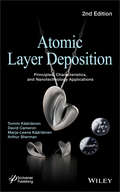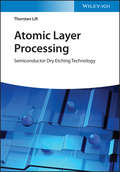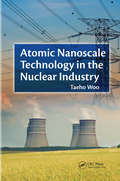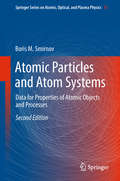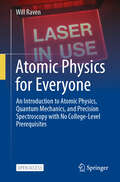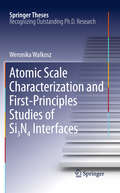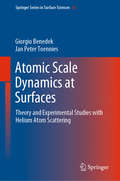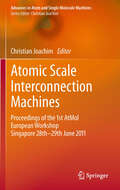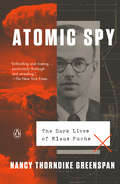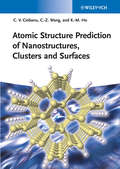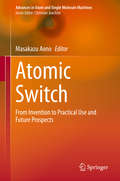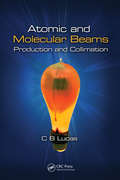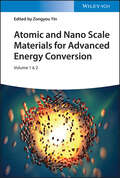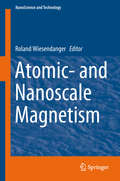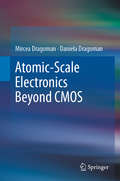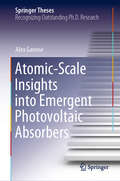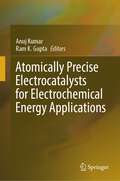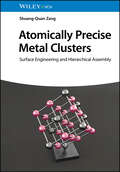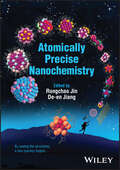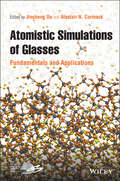- Table View
- List View
Atomic Layer Deposition: Principles, Characteristics, and Nanotechnology Applications
by Arthur Sherman David Cameron Marja-Leena Kääriäinen Tommi KääriäinenSince the first edition was published in 2008, Atomic Layer Deposition (ALD) has emerged as a powerful, and sometimes preferred, deposition technology. The new edition of this groundbreaking monograph is the first text to review the subject of ALD comprehensively from a practical perspective. It covers ALD's application to microelectronics (MEMS) and nanotechnology; many important new and emerging applications; thermal processes for ALD growth of nanometer thick films of semiconductors, oxides, metals and nitrides; and the formation of organic and hybrid materials.
Atomic Layer Processing: Semiconductor Dry Etching Technology
by Thorsten LillLearn about fundamental and advanced topics in etching with this practical guide Atomic Layer Processing: Semiconductor Dry Etching Technology delivers a hands-on, one-stop resource for understanding etching technologies and their applications. The distinguished scientist, executive, and author offers readers in-depth information on the various etching technologies used in the semiconductor industry, including thermal, isotropic atomic layer, radical, ion-assisted, and reactive ion etching. The book begins with a brief history of etching technology and the role it has played in the information technology revolution, along with a collection of commonly used terminology in the industry. It then moves on to discuss a variety of different etching techniques, before concluding with discussions of the fundamentals of etching reactor design and newly emerging topics in the field such as the role played by artificial intelligence in the technology. Atomic Layer Processing includes a wide variety of other topics as well, all of which contribute to the author’s goal of providing the reader with an atomic-level understanding of dry etching technology sufficient to develop specific solutions for existing and emerging semiconductor technologies. Readers will benefit from: A complete discussion of the fundamentals of how to remove atoms from various surfaces An examination of emerging etching technologies, including laser and electron beam assisted etching A treatment of process control in etching technology and the role played by artificial intelligence Analyses of a wide variety of etching methods, including thermal or vapor etching, isotropic atomic layer etching, radical etching, directional atomic layer etching, and more Perfect for materials scientists, semiconductor physicists, and surface chemists, Atomic Layer Processing will also earn a place in the libraries of engineering scientists in industry and academia, as well as anyone involved with the manufacture of semiconductor technology. The author’s close involvement with corporate research & development and academic research allows the book to offer a uniquely multifaceted approach to the subject.
Atomic Nanoscale Technology in the Nuclear Industry (Devices, Circuits, and Systems)
by Taeho WooDevelopments at the nanoscale are leading to new possibilities and challenges for nuclear applications in areas ranging from medicine to international commerce to atomic power production/waste treatment. Progress in nanotech is helping the nuclear industry slash the cost of energy production. It also continues to improve application reliability and safety measures, which remain a critical concern, especially since the reactor disasters in Japan. Exploring the new wide-ranging landscape of nuclear function, Atomic Nanoscale Technology in the Nuclear Industry details the breakthroughs in nanoscale applications and methodologies that are revolutionizing power production, biotechnology, and material science. Developments in atomic nanoscale technology have given us the ability to: Use ion beams to Investigate and optimize radiation energy losses at the nanoscopic level Assess nanoscopic safety circumstances involved in a reactor failure Analyze characteristics of nuclear spacecraft operating in the nanogravity of deep space Evaluate light collection enhancement for digital X-ray detection Apply brachytherapy using radioisotopes for cancer therapy Treat nuclear waste at the nanoscopic level Use systems-thinking decision making to analyze financial progress of nanotech in the energy industry Assess safety (and safety management methods) for nuclear nanomaterials used in plant operations Representing a first step in multi-combinatorial research, this text incorporates advanced studies that use Monte Carlo and solid-state measurement (including radiation detection) methods. Researchers used these to demonstrate the potential to upgrade methods of radiation protection and nuclear reactor operation (safety, waste disposal, etc.). The author also addresses how we can use nanotechnology to address industrial concerns and enhance nuclear medicine techniques. He highlights several nanomaterial systems and devices to illustrate developments in this area. About the Author: Taeho Woo launched the specialized field of atomic multinology (interdisciplinary research of nuclear technology), which combines the application of information technology, biotechnology, and nanotechnology in the nuclear industry.
Atomic Particles and Atom Systems: Data for Properties of Atomic Objects and Processes (Springer Series on Atomic, Optical, and Plasma Physics #51)
by Boris M. SmirnovThis book presents physical units and widely used physical formulas, which are given together with conversion factors in various units. It includes frequently used atomic spectra and data for atoms, ions and molecules, as well as potential curves for diatomic molecules, and provides numerical parameters for transport phenomena in gases and plasmas. Further, the rate constants of a number of processes in atmospheric ionized air have been added to this second edition of the book. The numerical data has been selected from the information on atoms, atomic systems, atomic processes and models for atomic physics in this area, and the numerical parameters of atoms, ions and atom systems are included in periodical tables of elements.
Atomic Physics for Everyone: An Introduction to Atomic Physics, Quantum Mechanics, and Precision Spectroscopy with No College-Level Prerequisites
by Will RavenThis open access textbook introduces beginning undergraduate students and high school students to the world of quantum mechanics and atomic spectroscopy. Requiring no previous knowledge of physics and no math beyond basic algebra and sines and cosines, this book focuses on concepts to make the excitement of atomic physics more accessible for learners than ever before. It comes replete with learning goals, exercises and solutions, and an optional experimental component, making this text readily adoptable for both the classroom and the undergraduate lab. The book takes the reader on a lively and engaging tour through topics at the forefront of current science, including photons, quantum numbers, atomic energy levels, some different spectroscopy techniques, electronic structure, atomic notation, angular momentum, hyperfine structure, isotope shifts, the strong force, an introduction to the Standard Model of Particle Physics, and more. This is an open access book.
Atomic Scale Characterization and First-Principles Studies of Si₃N₄ Interfaces (Springer Theses)
by Weronika WalkoszThis thesis presents results from a combined atomic-resolution Z-contrast and annular bright-field imaging and electron energy loss spectroscopy in the Scanning Transmission Electron Microscopy, as well as first principles studies of the interfaces between crystalline β--Si3N4 and amorphous (i) CeO2-x as well as (ii) SiO2 intergranular film (IGF). These interfaces are of a great fundamental and technological interest because they play an important role in the microstructural evolution and mechanical properties of Si3N4 ceramics used in many high temperature and pressure applications. The main contribution of this work is its detailed description of the bonding characteristics of light atoms, in particular oxygen and nitrogen, at these interfaces, which has not been achieved before. The atomic-scale information on the arrangement of both light and heavy atoms is critical for realistic modeling of interface properties, such as interface strength and ion transport, and will facilitate increased control over the performance of ceramic and semiconductor materials for a wide-range of applications.
Atomic Scale Dynamics at Surfaces: Theory and Experimental Studies with Helium Atom Scattering (Springer Series in Surface Sciences #63)
by Giorgio Benedek Jan Peter ToenniesExperimental advances in helium atom scattering spectroscopy over the last forty years have allowed the measurement of surface phonon dispersion curves of more than 200 different crystal surfaces and overlayers of insulators, semiconductors and metals. The first part of the book presents, at a tutorial level, the fundamental concepts and methods in surface lattice dynamics, and the theory of atom-surface interaction and inelastic scattering in their various approximations, up to the recent electron-phonon theory of helium atom scattering from conducting surfaces. The second part of the book, after introducing the experimentalist to He-atom spectrometers and the rich phenomenology of helium atom scattering from corrugated surfaces, illustrates the most significant experimental results on the surface phonon dispersion curves of various classes of insulators, semiconductors, metals, layered crystals, topological insulators, complex surfaces, adsorbates, ultra-thin films and clusters. The great potential of helium atom scattering for the study of atomic scale diffusion, THz surface collective excitations, including acoustic surface plasmons, and the future prospects of helium atom scattering are presented in the concluding chapters. The book will be valuable reading for all researchers and graduate students interested in dynamical processes at surfaces.
Atomic Scale Interconnection Machines: Proceedings of the 1st AtMol European Workshop Singapore 28th-29th June 2011 (Advances in Atom and Single Molecule Machines)
by Christian JoachimThis volume documents the first International Workshop on Atomic Scale Interconnection Machines organised by the European Integrated Project AtMol in June 2011 in Singapore. The four sessions, discussed here in revised contributions by high level speakers, span the subjects of multi-probe UHV instrumentation, atomic scale nano-material nanowires characterization, atomic scale surface conductance measurements, surface atomic scale mechanical machineries. This state-of-the-art account brings academic researchers and industry engineers access to the tools they need to be at the forefront of the atomic scale technology revolution.
Atomic Spy: The Dark Lives of Klaus Fuchs
by Nancy Thorndike Greenspan"Nancy Greenspan dives into the mysteries of the Klaus Fuchs espionage case and emerges with a classic Cold War biography of intrigue and torn loyalties. Atomic Spy is a mesmerizing morality tale, told with fresh sources and empathy." --Kai Bird, author of The Good Spy and coauthor of American Prometheus: The Triumph and Tragedy of J. Robert OppenheimerThe gripping biography of a notorious Cold War villain--the German-born British scientist who handed the Soviets top-secret American plans for the plutonium bomb--showing a man torn between conventional loyalties and a sense of obligation to a greater good.German by birth, British by naturalization, Communist by conviction, Klaus Fuchs was a fearless Nazi resister, a brilliant scientist, and an infamous spy. He was convicted of espionage by Britain in 1950 for handing over the designs of the plutonium bomb to the Russians, and has gone down in history as one of the most dangerous agents in American and British history. He put an end to America's nuclear hegemony and single-handedly heated up the Cold War. But, was Klaus Fuchs really evil?Using archives long hidden in Germany as well as intimate family correspondence, Nancy Thorndike Greenspan brings into sharp focus the moral and political ambiguity of the times in which Fuchs lived and the ideals with which he struggled. As a university student in Germany, he stood up to Nazi terror without flinching, and joined the Communists largely because they were the only ones resisting the Nazis. After escaping to Britain in 1933, he was arrested as a German émigré--an "enemy alien"--in 1940 and sent to an internment camp in Canada. His mentor at university, renowned physicist Max Born, worked to facilitate his release. After years of struggle and ideological conflict, when Fuchs joined the atomic bomb project, his loyalties were firmly split. He started handing over top secret research to the Soviets in 1941, and continued for years from deep within the Manhattan Project at Los Alamos. Greenspan's insights into his motivations make us realize how he was driven not just by his Communist convictions but seemingly by a dedication to peace, seeking to level the playing field of the world powers.With thrilling detail from never-before-seen sources, Atomic Spy travels across the Germany of an ascendant Nazi party; the British university classroom of Max Born; a British internment camp in Canada; the secret laboratories of Los Alamos; and Eastern Germany at the height of the Cold War. Atomic Spy shows the real Klaus Fuchs--who he was, what he did, why he did it, and how he was caught. His extraordinary life is a cautionary tale about the ambiguity of morality and loyalty, as pertinent today as in the 1940s.
Atomic Structure Prediction of Nanostructures, Clusters and Surfaces
by Cai-Zhuan Wang Cristian V. Ciobanu Kai-Ming HoThis work fills the gap for a comprehensive reference conveying the developments in global optimization of atomic structures using genetic algorithms. Over the last few decades, such algorithms based on mimicking the processes of natural evolution have made their way from computer science disciplines to solid states physics and chemistry, where they have demonstrated their versatility and predictive power for many materials. Following an introduction and historical perspective, the text moves on to provide an in-depth description of the algorithm before describing its applications to crystal structure prediction, atomic clusters, surface and interface reconstructions, and quasi one-dimensional nanostructures. The final chapters provide a brief account of other methods for atomic structure optimization and perspectives on the future of the field.
Atomic Switch: From Invention to Practical Use and Future Prospects (Advances in Atom and Single Molecule Machines)
by Masakazu AonoWritten by the inventors and leading experts of this new field, the book results from the International Symposium on “Atomic Switch: Invention, Practical use and Future Prospects” which took place in Tsukuba, Japan on March 27th - 28th, 2017. The book chapters cover the different trends from the science and technology of atomic switches to their applications like brain-type information processing, artificial intelligence (AI) and completely novel functional electronic nanodevices. The current practical uses of the atomic switch are also described. As compared with the conventional semiconductor transistor switch, the atomic switch is more compact (~1/10) with much lower power consumption (~1/10) and scarcely influenced by strong electromagnetic noise and radiation including cosmic rays in space (~1/100). As such, this book is of interest to researchers, scholars and students willing to explore new materials, to refine the nanofabrication methods and to explore new and efficient device architectures.
Atomic and Electronic Properties of 2D Moiré Interfaces (Springer Theses)
by Astrid WestonThis thesis provides the first atomic length-scale observation of the structural transformation (referred to as lattice reconstruction) that occurs in moiré superlattices of twisted bilayer transition metal dichalcogenides (TMDs) at low (θ Studies using Scanning transmission electron microscopy (STEM), a powerful tool for atomic-scale imaging, were limited due to the complexity of the (atomically-thin) sample fabrication requirements. This work developed a unique way to selectively cut and re-stack monolayers of TMDs with a controlled rotational twist angle which could then be easily suspended on a TEM grid to meet the needs of the atomically thin sample requirements. The fabrication technique enabled the study of the two common stacking-polytypes including 3R and 2H (using MoS2 and WS2 as the example) as well as their structural evolution with decreasing twist-angle.Atomic-scale studies were followed by a comprehensive investigation of their electronic properties using scanning probe microscopy and electrical transport measurements of the artificially-engineered structures. The electronic structure of two common stacking-polytypes (3R and 2H) were strikingly different, as revealed by conductive atomic force microscopy. Further studies focused on the 3R-stacking polytype to reveal room-temperature out-of-plane ferroelectricity using tools such as kelvin probe force microscopy, scanning electron microscopy and electrical transport measurements. This work highlights that the unique intrinsic properties of TMDs (i.e. semiconductors with strongly light-matter interaction) combined with the additional twisted degree-of-freedom has great potential to create atomically thin transistors/LEDs with built-in memory storage functions and will further aid in the development of the next generation of optoelectronics.
Atomic and Molecular Beams: Production and Collimation
by Cyril Bernard LucasAtomic and molecular beams are employed in physics and chemistry experiments and, to a lesser extent, in the biological sciences. These beams enable atoms to be studied under collision-free conditions and allow the study of their interaction with other atoms, charged particles, radiation, and surfaces. Atomic and Molecular Beams: Production and Col
Atomic and Molecular Spectroscopy: Basic Aspects and Practical Applications (Graduate Texts in Physics)
by Sune SvanbergA wide-ranging review of modern spectroscopic techniques such as X-ray, photoelectron, optical and laser spectroscopy, and radiofrequency and microwave techniques. On the fundamental side the book focuses on physical principles and the impact of spectroscopy on our understanding of the building blocks of matter, while in the area of applications particular attention is given to those in chemical analysis, photochemistry, surface characterisation, environmental and medical diagnostics, remote sensing and astrophyscis. The Fourth Edition also provides the reader with an update on laser cooling and trapping, Bose-Einstein condensation, ultra-fast spectroscopy, high-power laser/matter interaction, satellite-based astronomy and spectroscopic aspects of laser medicine.
Atomic and Nano Scale Materials for Advanced Energy Conversion
by Zongyou YinAtomic and Nano Scale Materials for Advanced Energy Conversion Discover the latest advancements in energy conversion technologies used to develop modern sustainable energy techniques In Atomic and Nano Scale Materials for Advanced Energy Conversion, expert interdisciplinary researcher Dr. Zongyou Yin delivers a comprehensive overview of nano-to-atomic scale materials science, the development of advanced electrochemical, photochemical, photoelectrochemical, and photovoltaic energy conversion strategies, and the applications for sustainable water splitting and other technologies. The book offers readers cutting-edge information of two-dimensional nano, mixed-dimensional nano, nano rare earth, clusters, and single atoms. It constructively evaluates emerging nano-to-atomic scale energy conversion technologies for academic research and development (R&D) researchers and industrial technique consultants and engineers. The author sets out a systematic analysis of recent energy-conversion science, covering topics like adaptable manufacturing of Van der Waals heterojunctions, mixed-dimensional junctions, tandem structures, and superlattices. He also discusses function-oriented engineering in polymorphic phases, photon absorption, excitons-charges conversion, non-noble plasmonics, and solid-liquid-gas interactions. Readers will also benefit from: A thorough introduction to emerging nanomaterials for energy conversion, including electrochemical, photochemical, photoelectrochemical, and photovoltaic energy conversion An exploration of clusters for energy conversion, including electrochemical, photochemical, and photoelectrochemical clusters Practical discussions of single atoms for energy conversion in electrochemical, photochemical, and photoelectrochemical energy conversion technologies A thorough analysis of future perspectives and directions in advanced energy conversion technology Perfect for materials scientists, photochemists, electrochemists, and inorganic chemists, Atomic and Nano Scale Materials for Advanced Energy Conversion is also a must-read resource for catalytic chemists interested in the intersection of advanced chemistry and physics in energy conversion technologies.
Atomic- and Nanoscale Magnetism (NanoScience and Technology)
by Roland Wiesendanger<p>This book provides a comprehensive overview of the fascinating recent developments in atomic- and nanoscale magnetism, including the physics of individual magnetic adatoms and single spins, the synthesis of molecular magnets for spintronic applications, and the magnetic properties of small clusters as well as non-collinear spin textures, such as spin spirals and magnetic skyrmions in ultrathin films and nanostructures. <p>Starting from the level of atomic-scale magnetic interactions, the book addresses the emergence of many-body states in quantum magnetism and complex spin states resulting from the competition of such interactions, both experimentally and theoretically. It also introduces novel microscopic and spectroscopic techniques to reveal the exciting physics of magnetic adatom arrays and nanostructures at ultimate spatial and temporal resolution and demonstrates their applications using various insightful examples. The book is intended for researchers and graduate students interested in recent developments of one of the most fascinating fields of condensed matter physics.</p>
Atomic-Scale Electronics Beyond CMOS
by Mircea Dragoman Daniela DragomanThis book explores emerging topics in atomic- and nano-scale electronics after the era of Moore’s Law, covering both the physical principles behind, and technological implementations for many devices that are now expected to become key elements of the future of nanoelectronics beyond traditional complementary metal-oxide semiconductors (CMOS). Moore’s law is not a physical law itself, but rather a visionary prediction that has worked well for more than 50 years but is rapidly coming to its end as the gate length of CMOS transistors approaches the length-scale of only a few atoms. Thus, the key question here is: “What is the future for nanoelectronics beyond CMOS?” The possible answers are found in this book. Introducing novel quantum devices such as atomic–scale electronic devices, ballistic devices, memristors, superconducting devices, this book also presents the reader with the physical principles underlying new ways of computing, as well as their practical implementation. Topics such as quantum computing, neuromorphic computing are highlighted here as some of the most promising candidates for ushering in a new era of atomic-scale electronics beyond CMOS.
Atomic-Scale Insights into Emergent Photovoltaic Absorbers (Springer Theses)
by Alex GanoseThis book presents an original investigation into alternative photovoltaic absorbers. Solar power is a highly promising renewable energy solution; however, its success is hampered by the limited cost-effectiveness of current devices. The book assesses the photovoltaic performance of over 20 materials using state-of-the-art, first-principles methods. Adopting a computational approach, it investigates atomic-scale properties at a level of accuracy that is difficult to achieve using laboratory-based experimental techniques. Unlike many theoretical studies, it provides specific advice to those involved in experimental investigations. Further, it proposes directions for future research. This book advances the field of photovoltaics in three crucial ways: firstly, it identifies why one class of proposed materials cannot achieve high efficiency, while at the same time gaining insights that can be used to design future absorbers. Secondly, it shows that poor performance in the bismuth chalcohalides is not due to fundamental limitations, and can be overcome by finely controlling synthesis conditions. Lastly, it describes a range of new stable materials that are expected to show excellent photovoltaic performance.
Atomically Dispersed Metallic Materials for Electrochemical Energy Technologies (Electrochemical Energy Storage and Conversion)
by Jiujun Zhang Xueliang Sun Wei Yan Shuhui Sun Xifei LiAtomically dispersed metallic materials (ADMMs) are the most advanced materials used in energy conversion and storage devices to improve their performance for portable electronics, electric vehicles, and stationary power stations. Atomically Dispersed Metallic Materials for Electrochemical Energy Technologies aims to facilitate research and development of ADMMs for applications in electrochemical energy devices. It provides a comprehensive description of the science and technology of ADMMs, including material selection, synthesis, characterization, and their applications in fuel cells, batteries, supercapacitors, and H2O/CO2/N2 electrolysis to encourage progress in commercialization of these clean energy technologies. Offers a comprehensive introduction to various types of ADMMs, their fabrication and characterization, and how to improve their performance Analyzes, compares, and discusses advances in different ADMMs in the application of electrochemical energy devices, including commercial requirements Describes cutting-edge methodologies in composite ADMM design, selection, and fabrication Summarizes current achievements, challenges, and future research directions Written by authors with strong academic and industry expertise, this book will be attractive to researchers and industry professionals working in the fields of materials, chemical, mechanical, and electrical engineering, as well as nanotechnology and clean energy.
Atomically Precise Electrocatalysts for Electrochemical Energy Applications
by Anuj Kumar Ram K. GuptaThis book offers a comprehensive overview of atomically precise electrocatalysts, including single-atom, dual-atom, and multi-atom catalysts, which are considered to be superior electrode materials for fuel cells and water electrolyzers. By presenting a systematic examination of these materials in ascending order of metal atom number, the book provides a deep understanding of their synthesis processes, energy applications, and potential for improving their performance. Unlike any contemporary book on the topic, this book explores the reaction mechanisms and structure-performance relationships in catalytic processes at atomic level. Essentially, by driving the development of fuel cells and water electrocatalyzers, this book helps meet the world's growing energy demands. With its cutting-edge insights, this book is an indispensable resource for researchers, engineers, and students working in the field of renewable energy.
Atomically Precise Metal Clusters: Surface Engineering and Hierarchical Assembly
by Shuang-Quan ZangAtomically Precise Metal Clusters Thorough discussion on how surface modification and self-assembly play roles in the atomically precise formation and property tailoring of molecular clusters Atomically Precise Metal Clusters: Surface Engineering and Hierarchical Assembly summarizes and discusses the surface modification, assembly, and property tailoring of a wide variety of nanoclusters, including the well-explored metal clusters, addressing the structure–property relationships throughout. The atomic-level control in synthesis, new types of structures, and physical/chemical properties of nanoclusters are illustrated in various chapters. The controlled modification and assembly of metal nanoclusters is expected to have a major impact on future nanoscience research and other areas, with distinctive metal cluster-based function materials with precise structures uncovering exciting opportunities in both fundamental research and practical applications. Written by a highly qualified academic with significant research experience in the field, Atomically Precise Metal Clusters includes information on: Ligand engineering and assembly of coinage metal nanoclusters such as gold, silver, and copperRecent advances in post-modification of polyoxometalates and small transition metal chalcogenide superatom clustersSynthesis and assembly of cadmium chalcogenide supertetrahedral clusters and modification and assembly of Fe-S clustersIndium phosphide magic-sized clusters, ligand-tailoring platinum and palladium clusters, and metal oxo clusters (MOCs)Enabling access to desired functions in metal clusters for catalysis, optics, biomedicine, and other fields through surface engineering and supramolecular assembly A timely and comprehensive book that summarizes the recent progress in the surface modification and self-assembly of metal nanoclusters, Atomically Precise Metal Clusters provides essential guidance for graduate students and advanced researchers in material science, chemistry, biomedicine, and other disciplines.
Atomically Precise Nanochemistry
by De-En Jiang Rongchao JinAtomically Precise Nanochemistry Explore recent progress and developments in atomically precise nanochemistry Chemists have long been motivated to create atomically precise nanoclusters, not only for addressing some fundamental issues that were not possible to tackle with imprecise nanoparticles, but also to provide new opportunities for applications such as catalysis, optics, and biomedicine. In Atomically Precise Nanochemistry, a team of distinguished researchers delivers a state-of-the-art reference for researchers and industry professionals working in the fields of nanoscience and cluster science, in disciplines ranging from chemistry to physics, biology, materials science, and engineering. A variety of different nanoclusters are covered, including metal nanoclusters, semiconductor nanoclusters, metal-oxo systems, large-sized organometallic nano-architectures, carbon clusters, and supramolecular architectures. The book contains not only experimental contributions, but also theoretical insights into the atomic and electronic structures, as well as the catalytic mechanisms. The authors explore synthesis, structure, geometry, bonding, and applications of each type of nanocluster. Perfect for researchers working in nanoscience, nanotechnology, and materials chemistry, Atomically Precise Nanochemistry will also benefit industry professionals in these sectors seeking a practical and up-to-date resource.
Atomistic Simulations of Glasses: Fundamentals and Applications
by Jincheng Du Alastair N. CormackA complete reference to computer simulations of inorganic glass materials In Atomistic Simulations of Glasses: Fundamentals and Applications, a team of distinguished researchers and active practitioners delivers a comprehensive review of the fundamentals and practical applications of atomistic simulations of inorganic glasses. The book offers concise discussions of classical, first principles, Monte Carlo, and other simulation methods, together with structural analysis techniques and property calculation methods for the models of glass generated from these atomistic simulations, before moving on to practical examples of the application of atomistic simulations in the research of several glass systems. The authors describe simulations of silica, silicate, aluminosilicate, borosilicate, phosphate, halide and oxyhalide glasses with up-to-date information and explore the challenges faced by researchers when dealing with these systems. Both classical and ab initio methods are examined and comparison with experimental structural and property data provided. Simulations of glass surfaces and surface-water reactions are also covered. Atomistic Simulations of Glasses includes multiple case studies and addresses a variety of applications of simulation, from elucidating the structure and properties of glasses for optical, electronic, architecture applications to high technology fields such as flat panel displays, nuclear waste disposal, and biomedicine. The book also includes: A thorough introduction to the fundamentals of atomistic simulations, including classical, ab initio, Reverse Monte Carlo simulation and topological constraint theory methods Important ingredients for simulations such as interatomic potential development, structural analysis methods, and property calculations are covered Comprehensive explorations of the applications of atomistic simulations in glass research, including the history of atomistic simulations of glasses Practical discussions of rare earth and transition metal-containing glasses, as well as halide and oxyhalide glasses In-depth examinations of glass surfaces and silicate glass-water interactions Perfect for glass, ceramic, and materials scientists and engineers, as well as physical, inorganic, and computational chemists, Atomistic Simulations of Glasses: Fundamentals and Applications is also an ideal resource for condensed matter and solid-state physicists, mechanical and civil engineers, and those working with bioactive glasses. Graduate students, postdocs, senior undergraduate students, and others who intend to enter the field of simulations of glasses would also find the book highly valuable.
Atomistic and Continuum Fracture Mechanics of Solids: An Integrated Treatment
by Shaker A. MeguidThis unique, first of its kind, book offers an integrated treatment of the atomistic-continuum behaviours of single and interacting microdefects under elasto-static loading. These microdefects may take the form of nanocracks, microcracks, microvoids, inclusions, and inhomogeneities. Professor Meguid elucidates the subject matter using novel treatment that offers a fresh look at molecular and continuum mechanics, imperfections in solids, the Griffith crack, modes of failure and diagnostics at varied length scales, LEFM and multiscale modeling of interacting microdefects. Providing a range of perspectives from theory and applications, this book is ideal for college seniors, graduate students, practicing and research engineers interested in failure analysis, diagnostics and prevention.
Atomistic and Continuum Modeling of Nanocrystalline Materials: Deformation Mechanisms and Scale Transition (Springer Series in Materials Science #112)
by Laurent CapolungoAtomistic and Continuum Modeling of Nanocrystalline Materials develops a complete and rigorous state-of-the-art analysis of the modeling of the mechanical behavior of nanocrystalline (NC) materials. Among other key topics, the material focuses on the novel techniques used to predict the behavior of nanocrystalline materials. Particular attention is given to recent theoretical and computational frameworks combining atomistic and continuum approaches. Also, the most relevant deformation mechanisms governing the response of nanocrystalline materials are addressed and discussed in correlation with available experimental data.
